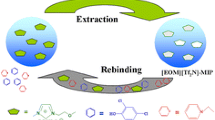Abstract
We present hybrid films consisting of a composite prepared from polystyrene (PS) and titanium dioxide (titania; TiO2) and molecularly imprinted with 1-pyrenebutyric acid (PBA). The interaction of PBA with the polymer is shown to occur via binding of the carboxylic group to TiO2 and hydrophobic interaction of the pyrene moiety with the PS network. We investigated the effects of the PS fraction on morphology, imprinting properties, and guest binding. The template could be completely removed by incubating the films in an acetonitrile solution of pyrene, which is due to the stronger π–π interaction between PBA and pyrene than the interaction between PBA and its binding site. A guest binding study with pyrene, 1-aminopyrene, pyrenemethanol, and anthracene-9-carboxylic acid showed that the hybrid films possessed selectivity and much higher binding capacity for PBA. This study demonstrates the first case of clear PS-assisted imprinting, where the π–π interaction of the template with a linear (non-crosslinked) polymer creates selective binding sites and enhances the binding capacity. This is a driving force for guest binding in addition to the interaction of the template/analyte with TiO2. All molecularly imprinted films displayed better binding, repeatability and reversibility compared to the respective non-imprinted films.

Illustration of the fabricated polystyrene/titania hybrids imprinted with 1-pyrenebutyric acid providing the interaction between the organic and inorganic components through the pyrene and carboxylic moieties








Similar content being viewed by others
References
Wulff G (1995) Molecular imprinting in cross-linked materials with the aid of molecular templates—A way towards artificial antibodies. Angew Chem Int Ed Engl 34:1812–1832
Lee SW, Ichinose I, Kunitake T (1998) Molecular imprinting of protected amino acids in ultrathin multilayers of TiO2 gel. Chem Lett 27:1193–1194
Fujishima A, Zhang X, Tryk DA (2008) TiO2 photocatalysis and related surface phenomena. Surf Sci Rep 63:515–582
Su C, Hong BY, Tseng CM (2004) Sol–gel preparation and photocatalysis of titanium dioxide. Catal Today 96:119–126
Hsu CY, Lin HY, Thomas JL, Wu BT, Chou TC (2006) Incorporation of styrene enhances recognition of ribonuclease A by molecularly imprinted polymers. Biosens Bioelectron 22:355–363
Yang P, Deng T, Zhao D, Feng P, Pine D, Chmelka BF, Whitesides GM, Stucky GD (1998) Hierarchically ordered oxides. Science 282:2244–2246
Holland BT, Blanford CF, Do T, Stein A (1999) Synthesis of highly ordered, three-dimensional, macroporous structures of amorphous or crystalline inorganic oxides, phosphates, and hybrid composites. Chem Mater 11:795–805
Kartsonakis IA, Liatsi P, Danilidis I, Bouzarelou D, Kordas G (2008) Synthesis, characterization and antibacterial action of hollow titania spheres. J Phys Chem Solids 69:214–221
Jang IB, Sung JH, Choi HJ, Chin I (2005) Synthesis and characterization of titania coated polystyrene core-shell spheres for electronic ink. Synth Met 152:9–12
Wijnhoven JEGJ, Bechger L, Vos WL (2001) Fabrication and characterization of large macroporous photonic crystals in titania. Chem Mater 13:4486–4499
Yi J, Lu D, Li X, Hu S, Li W, Lei J, Wang Y (2012) Preparation and performance of porous titania with a trimodal pore system as anode of lithium ion battery. J Solid State Electrochem 16:443–448
Liu WL, Wang L, Zhang LD, Xu WH, Chen SH, Wang XQ, Duan XL (2012) Superhydrophobic surface by immobilization of polystyrene on vinyl-modified titania nanoparticles. Journal of Sol–gel. Sci Technol 62:424–431
Hou W, Wang Q (2009) UV-driven reversible switching of a polystyrene/titania nanocomposite coating between superhydrophobicity and superhydrophilicity. Langmuir 25:6875–6879
Villafiorita-Monteleone F, Canale C, Caputo G, Cozzoli PD, Cingolani R, Fragouli D, Athanassiou A (2011) Controlled swapping of nanocomposite surface wettability by multilayer photopolymerization. Langmuir 27:8522–8529
Mao X, Hu B, He M, Chen B (2012) High polar organic–inorganic hybrid coating stir bar sorptive extraction combined with high performance liquid chromatography-inductively coupled plasma mass spectrometry for the speciation of seleno-amino acids and seleno-oligopeptides in biological samples. J Chromatogr A 1256:32–39
Mizutani N, Korposh S, Selyanchyn R, Yang DH, Lee CS, Lee SW, Kunitake T (2012) One-step fabrication of polystyrene-TiO2 nanosandwich film by phase separation. Chem Lett 41:552–554
Schmidt RH, Haupt K (2005) Molecularly imprinted polymer films with binding properties enhanced by the reaction-induced phase separation of a sacrificial polymeric porogen. Chem Mater 17:1007–1016
Schmidt RH, Belmont AS, Haupt K (2005) Porogen formulations for obtaining molecularly imprinted polymers with optimized binding properties. Anal Chim Acta 542:118–124
Ichinose I, Kikuchi T, Lee SW, Kunitake T (2002) Imprinting and selective binding of di- and tri-peptides in ultrathin TiO2-gel films in aqueous solutions. Chem Lett 31:104–105
Kunitake T, Lee SW (2004) Molecular imprinting in ultrathin titania gel films via surface sol–gel process. Anal Chim Acta 504:1–6
Lee SW, Ichinose I, Kunitake T (1998) Molecular imprinting of azobenzene carboxylic acid on a TiO2 ultrathin film by the surface sol–gel process. Langmuir 14:2857–2863
Lee SW, Ichinose I, Kunitake T (2002) Enantioselective binding of amino acid derivatives onto imprinted TiO2 ultrathin films. Chem Lett 31:678–679
Yang DH, Lee SW, Kunitake T (2005) Facile fabrication of molecularly imprinted cavities in spin-coated TiO2 nanofilms. Chem Lett 34:1686–1687
Mizutani N, Yang DH, Selyanchyn R, Korposh S, Lee SW, Kunitake T (2011) Remarkable enantioselectivity of molecularly imprinted TiO2 nano-thin films. Anal Chim Acta 694:142–150
Komiyama M, Takeuchi T, Mukawa T, Asanuma H (2003) Molecular imprinting. Wiley-VCH, Weinheim
Acknowledgments
This work was supported by MEXT via the 2nd Kitakyushu Knowledge-based Cluster Project. R. Selyanchyn acknowledges the Japan Society for the Promotion of Science (JSPS) for research fellowship for Young Scientists (JSPS-DC2).
Author information
Authors and Affiliations
Corresponding author
Electronic supplementary material
Below is the link to the electronic supplementary material.
ESM 1
(PDF 854 kb)
Rights and permissions
About this article
Cite this article
Selyanchyn, R., Lee, SW. Molecularly imprinted polystyrene–titania hybrids with both ionic and π–π interactions: a case study with pyrenebutyric acid. Microchim Acta 180, 1443–1452 (2013). https://doi.org/10.1007/s00604-013-1095-3
Received:
Accepted:
Published:
Issue Date:
DOI: https://doi.org/10.1007/s00604-013-1095-3




